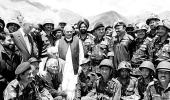India's tactical and operational response demonstrated its ability to prosecute tri-service operations, even without a formal tri-service doctrine or the higher command structure needed to coordinate it, points out Ajai Shukla.

A quarter of a century has elapsed since May-July 1999, when India and Pakistan fought a 74-day mini-war in the Kargil sector of the Line of Control -- the de facto border between the two countries.
The so-called Kargil conflict took the lives of more than 500 soldiers from each side and marked the culmination of a geopolitically-charged period in South Asia.
It is worth revisiting the tactical, strategic and diplomatic lessons that emerged from that conflict.
New Delhi went into the Kargil War at a particularly turbulent juncture in its history.
India's higher command structure -- led by Prime Minister Atal Bihari Vajpayee and advised by his hawkish Principal Secretary Brajesh Mishra and Cabinet members George Fernandes, Jaswant Singh and Yashwant Sinha -- was inclined to project power and favoured expeditionary (outward-looking) solutions to regional problems, such as the long-running Tamil Tigers insurgency in Sri Lanka.
In the circumstances, India's military was already bloodied by confrontations.
By 1992, the decade-old Pakistan-backed Sikh insurgency in Punjab was winding down, with even the most fanatical Sikhs realising they had run out of popular support in Punjab -- the only Sikh-majority province in India.
Earlier, the Indian military's intervention in Sri Lanka from 1987-1990 had been wound down, with the Tamil Tigers giving the Indian Peace Keeping Force (IPKF) a sharp lesson in the limits of power.
Assam was in turmoil due to the United Liberation Front of Assam.
Even as the IPKF was withdrawing from Sri Lanka, Jammu and Kashmir went up in flames in 1989-1990, with thousands of Kashmiri youngsters crossing the LoC into Pakistan occupied Kashmir (PoK) for weapons training in Pakistan-run camps.
The Union defence budget was at an all-time high of almost 4 per cent of gross domestic product.
With India's first Bharatiya Janata Party Prime Minister Atal Bihari Vajpayee, under pressure, New Delhi tested five nuclear explosive devices on May 11 and 13, 1998.
Despite intense international pressure on Pakistan not to retaliate in the same coin, Islamabad exploded six nuclear devices that same month -- symbolically, one more than India's.
Disregarding international criticism at adding two new 'States with nuclear weapons' to the existing list of five 'nuclear weapons States', Vajpayee began preparing for his historic bus journey to Lahore.
Meanwhile, far from the limelight, a tiny group of Pakistan Army planners began pushing infiltrators across the LoC into Kargil, with all the weapons, ammunition, fuel and food needed to sustain themselves through the coming winter, and the spring and summer fighting that would inevitably follow.
Pakistan had a simple tactical plan. The infiltrators would position artillery guns, ammunition, fuel, food and fire controllers to bring down artillery fire to interdict the Srinagar-Kargil-Leh road, blocking Indian supply lines to Kargil and the Siachen Glacier.
The strategic plan was to demonstrate the deterrent power of Pakistan's nuclear arsenal, establishing that despite the gravest provocation, Pakistan's nuclear arsenal would deter India from retaliating.
In the diplomatic realm, Pakistani planners felt confident that Indian diplomats would be unable to generate unacceptable pressure on Pakistan in global forums.
Eventually, pegged back militarily, stymied strategically and outwitted diplomatically, India would accept the new status quo in Kargil.
However, it played out quite differently. Despite the multitude of challenges, a stubborn New Delhi refused to step back.

New Delhi's first challenge was to demonstrate Pakistan's violation of an international treaty -- the Simla Agreement of 1972 -- in which both sides had pledged to maintain the status quo along the LoC.
Now, however, regular Pakistani troops had crossed the LoC, not just Kashmiri 'freedom fighters' as Islamabad claimed.
The proof of official Pakistani involvement came through an intelligence coup, in which Indian telephone monitoring agencies intercepted two phone calls between Lieutenant General Mohammed Aziz Khan, then the Pakistan army's powerful chief of general staff; and his boss Pakistan's army chief, General Pervez Musharraf, who was visiting Beijing to solicit Chinese support.
In discussions recorded by Indian intelligence, the generals boasted that they were in full control of the infiltrators in Kargil.
The Indian government presented this as irrefutable evidence of Pakistani irresponsibility, which -- were it not for New Delhi's restraint -- could have triggered nuclear war between the two nuclear-armed adversaries.
To avoid this, New Delhi's innovative tactics included the calibrated application of military force, notwithstanding the nuclearised backdrop.
India's 'graduated response', employed artillery first to inflict attrition; and then to 'shoot in' the infantry, along with attack helicopters and glide bombs.
India's tactical and operational response demonstrated its ability to prosecute tri-service operations, even without a formal tri-service doctrine or the higher command structure needed to coordinate it.
The Indian Air Force signalled Indian resolve early with bombing attacks on forward Pakistani positions and on the forward Pakistani logistic node of Muntho Dalo, rendering the infiltrators short of ammunition for the duration of the fighting.
With India's military mobilising with alarming alacrity, US President Bill Clinton summoned then Pakistan prime minister Nawaz Sharif to the US on July 4, 1999 for a personal dressing down.
Pakistan had run out of American goodwill. When Sharif reasoned that India had violated the Simla Agreement first by occupying the Siachen Glacier, Clinton sharply reminded him that the days of redrawing maps were over and that Pakistani troops should withdraw to the north of the LoC.
By the end of July, the status quo-ante was restored.

The Kargil War resulted in a high-level commission -- the Kargil Review Committee (KRC) -- which was independent India's first serious attempt at assessing the quantum of troops needed to defend its borders.
The KRC Report brought to light many grave deficiencies in India's security management system, including the fact that the original framework for management of the country's security, formulated by Lord Ismay and recommended by Lord Mountbatten, had been accepted by a national leadership that was not fully conversant with the complexities of national security management.
The KRC, its findings and recommendations reinforced by a Group of Ministers in 2000, also noted that all three divisions of the vast and contested territory of J&K were defended by two Indian Army corps -- 15 Corps in charge of Kashmir and Ladakh; and 16 Corps in charge of Jammu.
It was decided to carve out a separate corps zone from the current 15 Corps, which would be designated 14 Corps and given charge of Ladakh.
This has since been implemented, but there remains a dichotomy in the fact that 14 Corps is responsible for Kargil and the Siachen Glacier (both claimed by Pakistan); as well as for Eastern Ladakh (claimed by China).
This duality does not make for smooth command.
Feature Presentation: Aslam Hunani/Rediff.com











